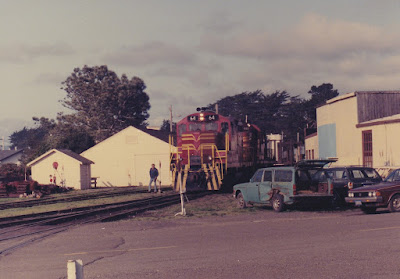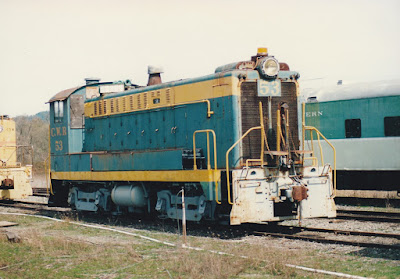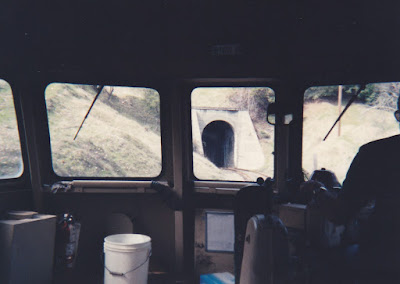 |
| Photo by Cliff West |
On our family's California trip, we arrived in Fort Bragg on the afternoon of March 17, 1992. Due to our unscheduled exploration of The Geysers, we were too late to ride the California Western Railroad to Willits, so we spent the night in Fort Bragg. Our motel in Fort Bragg was the best we stayed in during the entire trip. It was a fairly new motel with an indoor swimming pool. Meanwhile, my dad went down to the California Western depot and got these pictures of a California Western freight train arriving in Fort Bragg.
The California Western Railroad was originally built in 1885 by the Fort Bragg Lumber Company as the Fort Bragg Railroad. In 1904, passenger service was inaugurated. On July 1, 1905, the railroad was renamed the California Western Railroad & Navigation Company. The railroad was completed to Willits and a connection with the Northwestern Pacific Railroad on December 11, 1911. Self-propelled gas-powered railcars were added for passenger service in 1925, they were nicknamed "skunks" because of the smell of their exhaust. The "skunks" soon took over passenger service, and regular steam-powered passenger train service ended in November 1929. On December 19, 1947, the name was shortened to California Western Railroad. In June 1987, the California Western was sold to Kyle Railways.
 |
| Photo by Cliff West |
California Western GP9R #64 was originally built by the Electro-Motive Division of General Motors in January 1955 as Southern Pacific #5607. In 1965 it was renumbered to #3444. It was rebuilt at Southern Pacific's Sacramento General Shops to GP9R #3311 on May 11, 1970. It was retired by Southern Pacific on December 17, 1986 and sold to Metal Processing, Inc. in Vinton, Texas on January 2, 1988. It was resold later that year to Kyle Railways as #1750, and was transferred to the California Western in May 1989.
The second locomotive is California Western RS11 #62. It was originally built by Alco Products in April 1959 as Southern Pacific #5854. In 1965 it was renumbered to #2919. It was sold to Kyle Railways on January 10, 1980, and was later assigned to the California Western.
The next day, we rode the California Western Railroad’s “Skunk Train” from Fort Bragg to Willits and back. While we waited for departure time, we made a souvenir flatted penny in a machine in the depot. I also got a single-use camera so I could take pictures of the ride. I took this picture of California Western motorcar M-300 waiting in front of the Fort Bragg depot for passengers to board.
Motorcar M-300 is a Motorailer built by American Car & Foundry in 1935 as Seaboard Air Line #2026. It was the third of a group of three built for the Seaboard. It became Aberdeen & Rockfish #106 in 1944 and then became Salt Lake, Garfield & Western MC-3 in 1951. It was purchased by the California Western in 1963.
 |
| Photo by Cliff West |
Dad took this picture of the front end of motorcar M-300 at Northspur, the midpoint of the line, where the train makes a brief stop. Passengers have the option of remaining in Northspur, where there is a picnic area, and waiting for the train to return from Willits.
Since I took a picture of the front of motorcar M-300 in Fort Bragg, I took this picture of the rear end at Northspur.
 |
| Photo by Cliff West |
At one point the railroad goes around several horseshoe curves, and another part of the line appears to be a parallel track. My dad took this photo to illustrate it. This is one of the five horseshoe curves with a total length of 6.5 miles required to climb 932 feet between two points 1.5 miles apart.
Here is a view from the train I took as it approached Tunnel #2, the second of the two tunnels on the line. This tunnel is 795 feet long and was completed in 1911.
 |
| Photo by Cliff West |
My dad took this picture of the train’s engineer at the controls.
I took this picture looking back at the interior of motorcar M-300 as we travelled, showing the light passenger load on this March weekday.
Here is a picture I took of a horse I spotted along the line as we approached Willits.
As we entered Willits, I spotted this green & white patrol car of the Mendocino County Sheriff's Office stopped at a railroad crossing on California State Route 20 and snapped a picture, as I’d never seen a green & white police car before. At this point the highway crosses Broaddus Creek, which parallels the railroad here.
 |
| Photo by Cliff West |
While the train was turned around in Willits, we had a little time to explore. At Willits, the California Western connected with the Northwestern Pacific Railroad, a subsidiary of the Southern Pacific. There was a variety of railroad equipment in Willits that my dad took the opportunity to photograph. Arcata & Mad River #102 is a General Electric 44-Tonner. It was built in 1950 for the Pine Flat Dam Contractors and was acquired in 1954 by the Arcata & Mad River Railroad, a small shortline that connected to the Northwestern Pacific Railroad at Arcata, California, north of Eureka. The Arcata & Mad River shut down on May 24, 1985, and the abandoned line was sold to the Eureka Southern in 1988. This locomotive was sold to a private owner and was stored in Willits. It has since been scrapped.
 |
| Photo by Cliff West |
Eureka Southern Caboose #51 is former Southern Pacific caboose #1101. It is a C-40-3 Class Caboose built by SP’s Los Angeles Shops in 1942. The Eureka Southern purchased the northern section of the Northwestern Pacific from the Southern Pacific in 1984, and operated from Eureka to Willits. The Eureka Southern would declare bankruptcy in April 1992, a month after our visit.
 |
| Photo by Cliff West |
California Western #53 is a DS-4-4-1000 built by the Baldwin Locomotive Works in 1949 as U.S. Army Corps of Engineers W8380. It was later sold to Pan American Engineering and was acquired by the California Western in 1956. It was retired in 1985 and sold to a John Bradley of Laytonville, California, but remained stored in Willits.
 |
| Photo by Cliff West |
Central California Traction #42 is an S-1 that was built by the American Locomotive Company (later called Alco Products) in 1942 as Northern Pacific Terminal Company #34 for use in Portland, Oregon. It was sold to Central California Traction in August 1965. It was retired and sold in March 1983 to a Jim Bruggere who stored it in Willits.
 |
| Photo by Cliff West |
California Western #57 is an S-12 originally built by Baldwin-Lima-Hamilton in September 1953 as Southern Pacific #1541. In 1965 it was renumbered to #2148. It was retired by Southern Pacific on May 24, 1973, and was sold to the California Western on August 9, 1973. The California Western sold it to John Bradley of Laytonville, California, in January 1985.
 |
| Photo by Cliff West |
Southern Pacific SD9R #4418 is wearing the “Kodachrome” paint scheme of the Southern Pacific’s aborted merger with the Atchison, Topeka and Santa Fe. It was originally built by the Electro-Motive Division of General Motors in May 1955 as Southern Pacific #5432. In 1965 it was renumbered to #3910. On November 5, 1976, it was upgraded at Southern Pacific's Sacramento General Shops as SD9R #4418. It was painted in SPSF's "Kodachrome" colors in 1986, and continued to wear them despite the merger being denied by the Interstate Commerce Commission on June 30, 1987, and would continue to wear them to its retirement on September 18, 1995.
 |
| Photo by Cliff West |
Eureka Southern #30 is a GP38 built by the Electro-Motive Division of General Motors in 1969 as Pennsylvania-Reading Seashore Lines #2007. It was built with dual control stands, and part of the front wall of the cab is extended forward a few inches to make a little more room to walk around the control stand.
 |
| Photo by Cliff West |
This locomotive became Conrail #7667 before being sold to Eureka Southern in 1984 with three other identical GP38s. All four locomotives would be sold shortly after Eureka Southern’s bankruptcy in April 1992.
After our train was turned around, we returned to the Willits depot and reboarded for the return trip to Fort Bragg. Here are some pictures I took of motorcar M-300’s control stand while we waited for departure time.
We departed Willits to return to Fort
Bragg aboard the train. Here is another view I took as we approached Tunnel #2, this time from
the other end.
Here is a view I took from onboard the train as it approached Tunnel #1. The train is on a trestle over the Noyo River right up until it enters the tunnel. The tunnel is 1,100 feet long and was completed in 1893.
 |
| Photo by Cliff West |
After returning to Fort Bragg, my dad took one last picture of California Western Caboose #11, on static display at the Fort Bragg depot. The plywood-bodied caboose was built in Fort Bragg in the 1960s, on the frame of a former Southern Pacific wood caboose.













No comments:
Post a Comment